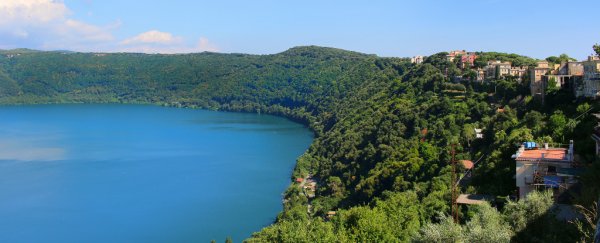Italian researchers say that a thought-to-be-extinct volcano named Colli Albani, which lies 30 kilometres (19 miles) from the centre of Rome, is actually still alive and active.
While this certainly sounds scary, the volcano isn't expected to erupt for another 1,000 or so years, giving researchers and citizens a chance to prepare – though the team does state that the pending eruption has the potential to be as devastating as that of Mount Vesuvius.
According to the team – led by Fabrizio Marra from the National Institute of Geophysics and Volcanology in Rome – the volcano was believed extinct because it erupts so infrequently. Based on their analysis, the volcano's last eruption took place 36,000 years ago.
Now, after a series of earthquakes in the 1990s and the formation of a steam vent, the team says Colli Albani - also known as the Alban Hills - is inflating, causing the surrounding area to rise about 2 millimetres (0.08 inches) every year.
In fact, over the last 200,000 years, the team says the region has risen about 50 metres (164 feet) in total, suggesting that magma is pooling beneath the volcano, reports Stephanie Pappas for Live Science.
The team was able to come to this conclusion after analysing ground-based data collected during the earthquakes in the region and the formation of steam vents in conjunction with satellite data and rock samples.
Now, the team says that all of Colli Albani's recent activity is likely due to a fracture that split apart beneath the volcano about 2,000 years ago. Over the years, this fracture has allowed more and more magma to rise into the volcano, making it expand, which also raises the ground above it, creates steam vents, and causes earthquakes.
They also conclude that the volcano is likely on a 31,000-year eruption cycle, meaning that – since it's been 36,000 years from its last eruption – it's definitely due, and the team says the next eruption will likely happen in about 1,000 years.
"Although Rome and its suburbs are not in any immediate danger, previous research shows that in past eruptive cycles the volcano unleashed both low blasts of hot ash and lava that rolled down the volcano's slopes at tremendous speeds," reports Elizabeth Deatrick from the American Geophysical Union (AGU).
While it's easy to hear this news and imagine the plot of a disaster film, there's likely nothing for Romans to be that worried about. As Erik Klemetti – a Wired blogger and assistant professor of Geosciences at Denison University – sums up elegantly:
"Since 69,000 years ago, much of the activity has been small explosive eruptions. Those might impact people/property right around the Colli Albani, but likely won't be a direct hazard for Rome. There is the potential for ash disruptions from such eruptions and people living in the area directly surrounding the eruption might be displaced for years (or forever). However, unless something has changed at the Colli Albani, the vigour in the activity has been in decline over the last half a million years."
In other words, an eruption of Colli Albani most likely wouldn't terribly impact those living within Rome, though those on the outskirts – and definitely those at the base of the volcano – might lose their homes or experience other types of property damage.
Either way, the team's findings indicate that the Colli Albani should be monitored rather closely, especially because of its proximity to a major city.
Colli Albani isn't the only volcano making headlines recently. Back in February, researchers witnessed Big Ben – a sub-Antarctic volcano – erupting on Heard Island, one of the most remote places on Earth. You can watch the team's video of the eruption here.
It will be exciting to see how much data researchers can collect while studying Colli Albani, which will hopefully lead to a better way of detecting and analysing volcanic activity in the future.
The new findings were recently published in the journal Geophysical Research Letters.
